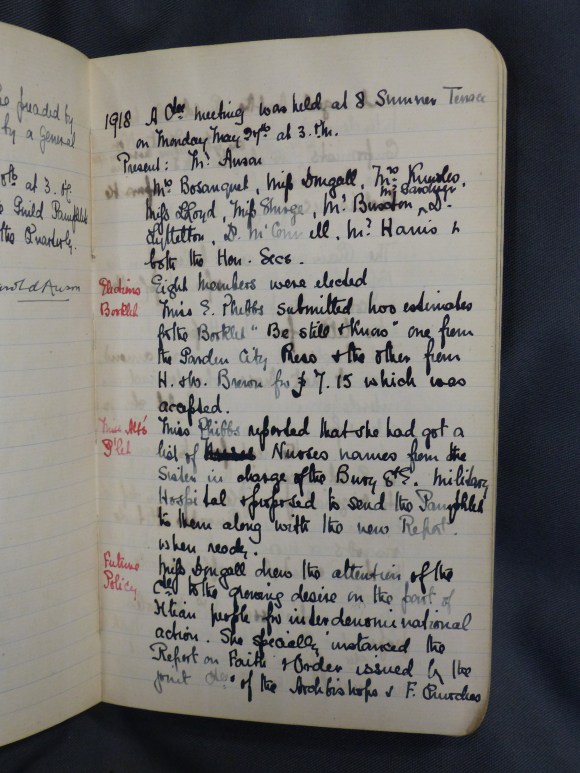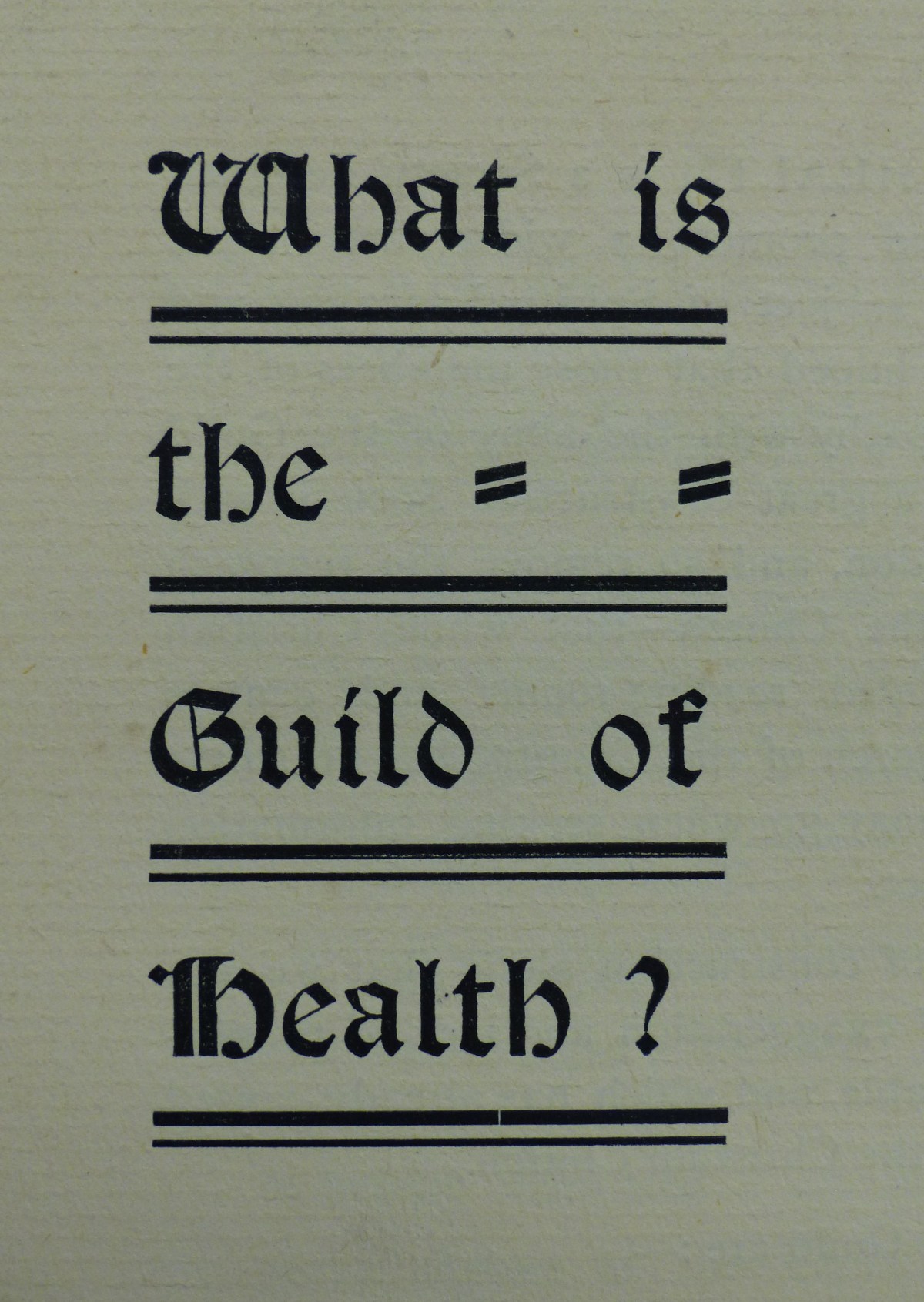This month’s item of interest by David Thomas (Library Assistant), looks at the early history of the Guild of Health.
Today, we are used to hearing about the importance of wellbeing and the impact this can have on both our mental and physical health. Mental health is discussed more than ever before and is finally being recognised on an equal footing with physical health. At the beginning of the 20th century these attitudes were rare in British society and the Church. The ministry of healing was being carried out by a minority of churches and ministers, some influenced by the Holiness movement within Methodism. Alongside this however, new religious denominations were being established that espoused spiritual healing while not adhering to traditional orthodox beliefs, in particular the Church of Christian Science. The Church of England and many other churches regarded faith healing movements with uncertainty and avoided official positions on the issue. It was this context that shaped the founding of the Guild of Health with its emphasis on both bodily and spiritual health and a desire to bring spiritual healing into mainstream Anglicanism.

The Guild of Health was founded in 1904 with Percy Dearmer as Chairman, B.S. Lombard, Honorary Secretary and Conrad Noel third member (see below for biographical information on the individuals mentioned). [1] The Guild was formed out of a meeting that had been organised with an ambition to “revive the principles and practice of the Ministry of Healing in the Church of England”.[2] Conrad Noel, writing about the impetus behind the meeting, stated that “The idea was that Christian Science and other health movements outside the Church had been driven into heresy by the Church herself having forgotten to preach spiritual healing and having lost the power to practise it. Hence this revival in the Church of England.”[3] The original membership was 400 and meetings were held across the country; at one such meeting G.K. Chesterton spoke on ‘Cheerfulness’.[4]
In an early pamphlet, ‘What is the Guild of Health?’ (G4337.G8W4 [P]), its objects were stated as follows:
- The study of the influence of spiritual upon physical well-being.
- The exercise of healing by spiritual means, in complete loyalty to scientific principles and methods.
- United prayer for the inspiration of the Holy Spirit in all efforts to heal the sick.
- The cultivation, through spiritual means, of both individual and corporate health.[5]
As may be expected in any new endeavour, there were differences of opinion amongst the leadership, with Conrad Noel and Percy Dearmer resigning in 1907 and 1908. Although Dearmer returned in 1913, the movement split in 1915 with the creation of the Guild of St Raphael. One of the reasons for this was that the Guild of Health wanted to be an interdenominational movement, of which Lily Dougall was an advocate. Anglo-Catholics within the Guild wanted to keep it as an Anglican organisation with a particular emphasis on priests anointing the sick.[6] Harold Anson, chairman of the Guild from 1909 to 1928,[7] recalled that the Guild was “mainly interested in the co-operation of religion, medicine and psychology, and laid no stress upon healing as a sacerdotal endowment”.[8] However, the two organisations remained on good terms and members of the Guild of St Raphael made contributions to the Guild of Health Magazine.

The Church of England was now paying more attention to spiritual healing and set up a committee to investigate its practice following the Lambeth Conference of 1920. Under the leadership of Harold Anson, the Guild became increasingly influential, Anson himself was a member on the Archbishop’s Committee. In 1922 the Guild started to hold weekly services at St Martin-in-the-Fields. William Temple’s (then Bishop of Manchester, later Archbishop of Canterbury) address at the 1924 Manchester Diocesan Conference on The Ministry of Healing was published by the Guild in their pamphlet series.
By 1924 the Guild had come of age, British membership stood at around 2500 and there were branches in America and across the Commonwealth. That year also saw the beginning of the Guild’s magazine The Guild of Health Monthly. John Maud, the Bishop of Kensington and president of the Guild wrote on ‘Healing by spiritual means’, arguing that “to treat body, mind and spirit separately we hold to be unscientific because we think of man’s being as a whole.”[9]
The Archbishop’s Report on The Ministry of Healing was published in January 1924.[10] It advocated dialogue and cooperation between doctors and clergy over the nature of healing and argued that spiritual healing should always have a spiritual end rather than just a physical outcome. It also confirmed the Biblical authority for anointing the sick and the laying-on of hands in prayer. This Report laid the foundation for the re-emergence of the healing ministry across the Anglican Church. Ninety years later the Guild of Health and the Guild of St Raphael reunited. The Guild continues to study the latest theological and scientific developments in healing and support the Church’s sacramental healing ministry.

Early committee members of the Guild of Health:
- Harold Anson (1867-1954), worked in New Zealand for several years and was later Master of the Temple Church, London from 1935-54.
- Noel Buxton (1869-1948), a Liberal MP who survived an assassination attempt in Romania while on a diplomatic mission to Bulgaria in 1914 and after the end of the War joined the Labour Party, serving in Ramsey MacDonald’s first cabinet.
- Percy Dearmer (1867-1936), who in 1909 wrote Body and Soul: An Enquiry into the Effect of Religion on Health. Dearmer is better known as the author of The Parson’s Handbook and his work with Ralph Vaughan Williams on The English Hymnal.
- Lily Dougall (1858-1923), born in Montreal, Canada. She was a novelist whose work featured the ‘new woman’ of the 1890s before she started writing about religion and philosophy. The leadership of the Guild held many meetings at her house in Cumnor, Oxfordshire.
- Bousfield Swan Lombard (1866-1951), the Vicar of All Hallows, North St Pancras, then Chaplain to the British Embassy in Petrograd (St Petersburg), Russia.
- John Maud (1860-1932), served as a vicar in Leeds and at St Mary, Redcliffe, Bristol before becoming Bishop of Kensington in 1911. He was the father of the civil servant Lord Redcliffe-Maud.
- Conrad Noel (1869-1942), the cousin of Noel Buxton and known as the ‘Red Vicar’ of Thaxted due to his left-wing politics, he was also a friend of the composer Gustav Holst. He was in turn a member of the Social Democratic Federation, the Independent Labour Party and the British Socialist Party.
- Maude Royden (1876-1956), a life-long preacher and campaigner for the ordination of women, she joined the committee in the 1920s. She later received an honorary degree as Doctor of Divinity from the University of Glasgow in 1931, becoming the first woman DD.
The Guild of Health and St Raphael recently donated a range of material to the library. The printed collection includes pamphlets published by the Guild from the 1910s onward, annual reports and the Guild Magazine (now called The Way of Life). Archive material contains Minute Books of the Executive Committee, the Magazine Committee, and the AGM respectively and records of accounts and events. The Guild pamphlets can all be found on the printed books catalogue by searching for series title, ‘Guild of Health’ and the archive collection uses the reference GOH on the archives catalogue.
[1] Dearmer, Nan, The Life of Percy Dearmer (London: Jonathan Cape, 1940), p. 187.
[2] Quoted in Gray, Donald, Percy Dearmer: a parson’s pilgrimage (Norwich: Canterbury Press), p. 80.
[3] Quoted in Dearmer, Nan, The Life of Percy Dearmer (London: Jonathan Cape, 1940), p. 187.
[4] Dearmer, Nan, The Life of Percy Dearmer (London: Jonathan Cape, 1940), p. 188.
[5] What is the Guild of Health? (London: Guild of Health, [19–]), p. [1].
[6] Anson, Harold, Looking forward (London: Heinemann, 1938), pp. 206-207.
[7] Mews, Stuart, ‘The revival of spiritual healing in the church of England, 1920-1926’ in The Church and healing (Oxford: Basil Blackwell, 1982), p. 311.
[8] Anson, Harold, Looking forward (London: Heinemann, 1938), p. 207.
[9] The Guild of Health Monthly Vol. 1, No. 1 (April 1924), p. 6.
[10] Mews, Stuart, ‘The revival of spiritual healing in the church of England, 1920-1926’ in The Church and healing (Oxford: Basil Blackwell, 1982), p. 324.

